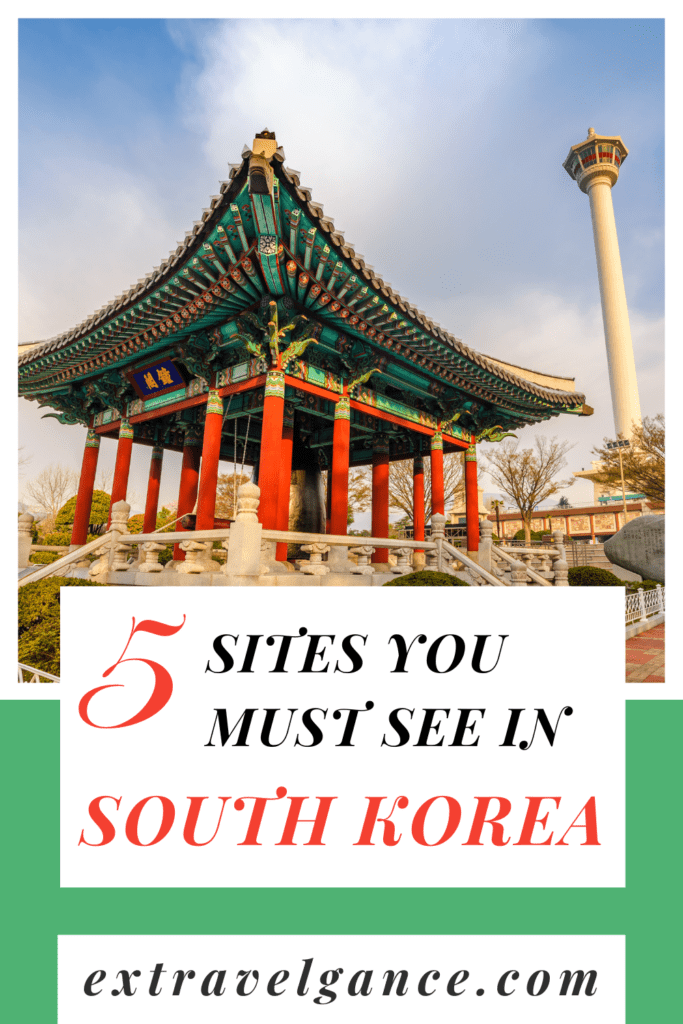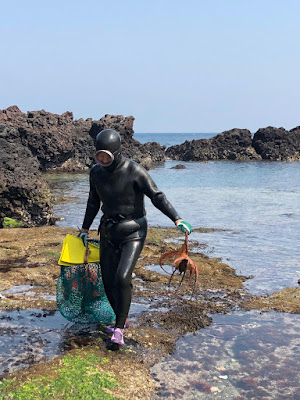
South Korea is the home of temples and palaces, bustling markets, amazing cuisine, beautiful parks, and K-Pop. If that is not enough, South Korea is also the capital of medical tourism (specifically cosmetic surgery and dermatology) and beauty products. In today’s post, we share 5 sites we believe you must see while in South Korea. Also, don’t miss our post Tips for an Amazing South Korea Trip!

In 1950-1953, the United Nations supported South Korea against North Korea in the Korean War. The Korean Armistice Agreement of 1953 ended the fighting but no peace treaty was signed, and the two countries are technically still at war. This war created a lasting impact on the nation, architecture, and people. Despite this, South Korea is a country filled with truly kind and considerate people as well as beautiful palaces and lavish temples.
Check out the following 5 sites you must see in South Korea:
Note: We may earn a small commission from the affiliate links below.

Demilitarized Zone (DMZ)
The Korean Demilitarized Zone (DMZ) is the buffer zone between the world’s most heavily armed borders of North and South Korea. The DMZ runs 160 miles and is 2.5 miles wide. This is NOT a border crossing! To travel between the two Koreas, you must first transfer to a third country. Plus, you cannot use a U.S. passport to travel to, in, or through North Korea without special validation from the US Department of State. The only places you can step into North Korea are the T1-T3 conference rooms (blue houses) at the demarcation line. When you visit the DMZ, you can look into North Korea from the observation platform on the South Korea side.
First, stop at the DMZ 3rd Infiltration Tunnel. The North Koreans created this tunnel to attack South Korea. It accommodates 30,000 troops with light weaponry per hour. This is one of four tunnels that were found, but there are likely more. You can walk through quite a bit of the South Korean side. They give you a hardhat to wear so you don’t hurt your head on the rocks above. It is easy to go down, but an entirely different story to go up the tunnel incline!
Also visit the nearby Dorasan Train Station. This was built in the early 2000’s as a symbol of the possibility of reunification of the North and South. This track runs in both the North and South. The station is largely symbolic and serves as inspiration for the possibility that there will be a reunification between North and South Korea. Unfortunately, the station sits idle.

Palaces and Temples
Seoul is filled with palace complexes hosting palaces, temples, and shrines. If you only have time to visit one while in Seoul, Gyeongbokgung Palace and the surrounding grounds is the most comprehensive. It consists of the king’s palace, the queen’s house, a ceremonial hall, the king’s pleasure house, and several other structures. The grounds are also home to the Folk Museum of Korea featuring native costumes, tools, household goods, and other items from daily life. The museum is outstanding.
If time allows, visit the Jongmyo Confucian Shrine. A designated a UNESCO World Heritage Site, the shrine is dedicated to the perpetuation of memorial services for the deceased kings and queens of the Korean Josean Dynasty. It is the oldest royal Confucian shrine preserved and today’s ritual ceremonies continue a tradition established in the 14th century. They do not allow people to stroll freely through the grounds, so be sure to check tour times and plan accordingly.
While strolling the grounds of temples and palaces, watch for young people dressed in Hanbok (traditional Korean clothing). Hanbok rental stores surround most palace complexes. For a fee, anyone can participate in this activity. Whether you choose to participate or not, this is definitely one of the 5 sites you must see in South Korea.

Hanok Village
South Korea boasts several Hanok villages where tourists can immerse themselves in traditional Korean village life. A hanok is a traditional Korean House. This style of architecture dates back to the 14th century. It positions the house in relation to its surroundings (ideally with a mountain in the back and river in the front).
Bukchon Hanok Village is located in the heart of Seoul on the top of a hill between Gyeongbok Palace, Changdeok Palace, and Jongmo Royal Shrine. It was the residential neighborhood of high-ranking government officials and nobility during the Joseon Dynasty. People still occupy these homes so be respectful of their privacy and other needs.
There are several other hanok villages throughout the country that may better fit your itinerary but be sure to visit one while in South Korea.

Haedong Yongungsa Temple
Set along the rocky coast of the Sea of Japan (East Sea), in Busan, you will find the Haedong Yongungsa Temple. Nestled between the sea and the mountains, this breathtaking temple complex near Haeundae Beach is a definite must see. Built in 1376, the temple was originally known as the Bomun Temple. However, it was destroyed during the Japanese invasion of Korea (1592–98) but was rebuilt in the 1930s.
Just in front of the Daeungjeon Main Sanctuary is a three-story pagoda with four lions. The four lions symbolize joy, anger, sadness, and happiness. On the right-hand side, inside the cave, is the Gulbeop Buddhist Sanctum. The Haesu Gwaneum Daebul (Seawater Great Goddess Buddha) and the Yongwangdang Shrine also look out at the sea.
There are 108 stairs and stone lanterns lining the rocky landscape culminating in a beautiful temple. At the midpoint of the 108 steps, you can stop and enjoy the calming waves. The temple is popular with sightseers, who gather to watch the sunrise on New Year’s Day. Sightseers also flock to the temple decorated with paper lanterns during Buddha’s Birthday celebrations.
This temple complex is a beautiful place to relax and people watch. Tourists come from all over the world to visit the complex and many followers of Buddha also choose this location to worship. Is it any wonder this is one of the 5 sites you must see in South Korea?

Jeju Island
Jeju Island is a volcanic island reminiscent of Hawaii. It’s a great place to add to your South Korea itinerary if you enjoy an active vacation. The island is home to several hiking paths including the Olle Trail featuring with breathtaking coastal views. You can also visit Manjamggul Lava Tube featuring the largest lava column in the world.
An uphill hike of the Sangumburi Sunset Crater is quite strenuous, but it’s worth the effort for the beautiful views. Once you hike down, you can see the Haenyeo Female Divers Demonstration. These talented women dive to the ocean floor, without scuba equipment, to collect seafood. Historically, men were charged taxes for their catch, so it became part of their cultural heritage for women to do the diving. The divers can hold their breath for three minutes and will dive 5-6 hours per day. Most are elderly – one of the ladies is 80 years old! During a demonstration, they will perform a special song and dance before collecting shells on the ocean floor. After bringing up the catch, they extract the creatures for your dining pleasure.
Need a break? Visit the Jeju Osulloc Tea Museum to experience a Korean tea ceremony. If you wish to purchase South Korean cosmetics, you can visit the adjacent Innisfree cosmetics shop. The Island’s volcanic ash soil and geothermic spring water result in the ingredients for famous South Korean skincare.
Getting Around
Seoul is a very walkable city. Be sure to bring two pairs of sturdy and comfortable shoes as you will want to rotate them out daily to give your feet a break. Seoul also has an excellent subway system with multi-lingual announcements and signage. It also has an extensive bus system, but that is better for Korean speakers. Be sure to pick up a T-money card at a nearby convenience store. Use this to pay for subway, bus, and taxi services.
The train system in South Korea is clean, efficient, and on-time. This is an easy and cost-efficient way to hop from Seoul to Busan on the Southern Coast. You can get to JeJu Island on a quick flight from Busan.
Busan is very spread out and connected by incredibly high and heavily trafficked bridges. Public transportation in Busan is not as easy as in Seoul. There is a hop-on/-off bus Loop Tour in Busan, but the bus does not include any commentary or stop announcements in English. It is still an easy and affordable way to move from site to site – as long as you watch for your stop! You can also grab a ride at taxi stands, but the easiest way is to download the Kakao T mobile app to hail a taxi when out and about.
Where to Stay
Note: we may earn a commission from the affiliate links below.
South Korea is teaming with clean and affordable hotels at all price points. The Aloft Seoul Myeongdong Hotel is reasonably priced and within walking distance of most “must-see” sites in Seoul. Another option is the Lotte Hotel World located just a half mile from Lotte World. Lotte World is a multi-faceted amusement complex the family will enjoy.
The Shilla Stay Haeundae in Busan is conveniently located across the street from Haeundae Beach and a short walk from the Busan Aquarium (one of the stops for the Loop Tour bus).
The Lotte City Hotel Jeju offers sweeping views from the tallest high-rise on the island and an all-season hot-water pool to relax in after an active day.
Which of the 5 sites you must see in South Korea most interest you?
Or do you have a sixth we should add to this list?
Tell us what you think below in the comments. You can also contact us and follow us on Facebook, Instagram and Pinterest so you never miss a post!


